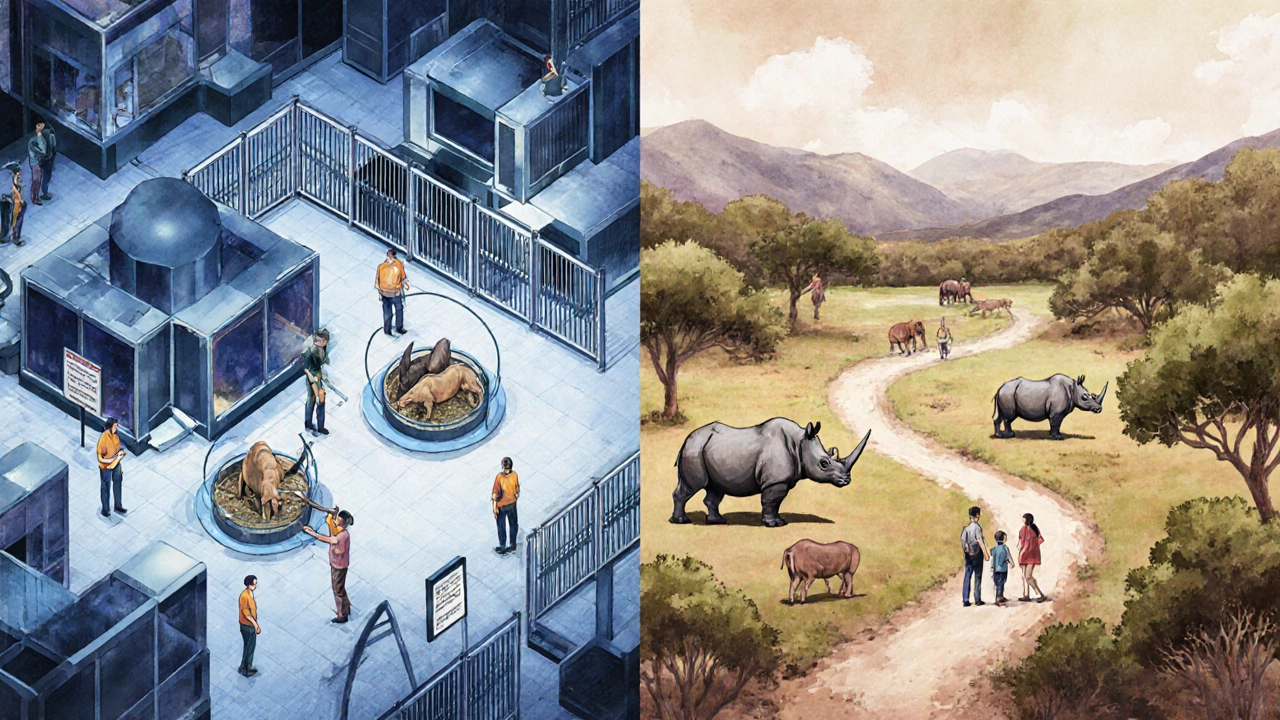Zoo or Sanctuary Decision Guide
This interactive tool helps you determine which wildlife experience aligns best with your priorities. Answer the questions below to get personalized recommendations based on the differences between zoos and sanctuaries discussed in the article.
Your Recommendation
Zoo Score: 0
Sanctuary Score: 0
When you plan a day out to see animals, the choice often boils down to a zoo or a sanctuary. Both promise close encounters, but the reality for the animals, the ecosystem, and even your own experience can be wildly different. Below we break down the key factors so you can decide which setting truly benefits wildlife.
Key Takeaways
- Zoos focus on education, research, and captive breeding; sanctuaries prioritize rehabilitation and long‑term freedom.
- Animal welfare standards are generally higher in sanctuaries because they avoid breeding for display.
- Conservation impact varies: zoos excel at species‑level breeding programs, while sanctuaries protect habitats and rescue individuals.
- Visitor experience differs - zoos offer curated shows, sanctuaries provide natural‑like observation.
- Choose based on whether you value education, species rescue, or habitat preservation.
What Is a Zoo?
Zoo is a facility that keeps wild animals in enclosures for public viewing, education, research, and conservation breeding. Modern zoos often belong to accredited networks, follow strict veterinary protocols, and run large‑scale education programs.
Typical features include themed zones, feeding demonstrations, and visitor pathways that bring you close to big cats, primates, and marine mammals. The underlying mission blends entertainment with scientific goals, aiming to inspire visitors to support wildlife causes.
What Is a Wildlife Sanctuary?
Wildlife sanctuary is a protected area that offers permanent refuge for rescued or native animals, emphasizing minimal human interference and natural behavior. Sanctuaries usually operate as non‑profits, relying on donations and volunteers rather than ticket revenue.
Instead of attractions, you’ll find expansive habitats where injured birds recuperate, rescued elephants roam large paddocks, and orphaned mammals grow up under the care of specialists before being released when possible.
Core Missions Compared
Both entities claim to help wildlife, but they prioritize different outcomes.
- Zoos aim to preserve species through captive breeding, fuel scientific research, and raise public awareness.
- Sanctuaries focus on rescuing individuals, providing rehabilitation, and, when feasible, re‑introducing them to the wild.
These missions drive everything from enclosure design to staff expertise.
Animal Welfare Standards
Welfare is measured by space, enrichment, veterinary care, and freedom from breeding stress. In a sanctuary, breeding is often prohibited unless it directly supports a release program. That reduces hormonal stress and allows animals to develop natural behaviors.
Zoos, especially accredited ones, meet high welfare benchmarks, but the pressure to breed rare species can sometimes conflict with individual comfort. Enrichment in zoos tends to be more structured-think puzzle feeders-while sanctuaries let animals interact with peers in a semi‑wild setting.

Conservation Impact
Conservation efforts differ in scale and method.
- Zoos contribute through Species Survival Plans, genetic banks, and funding field projects worldwide.
- Sanctuaries protect local ecosystems, serve as gene pools for rescued individuals, and sometimes act as safe corridors linking fragmented habitats.
Both models are valuable, but their impact pathways are distinct.
Education and Public Engagement
Education is a zoo’s bread and butter. Interactive talks, feeding shows, and school tours translate complex science into memorable moments. A zoo can host thousands of visitors daily, amplifying its messaging.
Sanctuaries rely on volunteer guides, low‑impact tours, and citizen‑science projects. While visitor numbers are smaller, the experience tends to be more immersive, fostering a deeper emotional connection to real‑world conservation challenges.
Visitor Experience and Ethics
Walking through a zoo, you expect clear signage, organized pathways, and scheduled activities. The trade‑off is that many enclosures, despite improvements, still feel artificial.
At a sanctuary, you might trek a nature trail, watch a rescued hawk glide over a meadow, or observe a herd of rescued rhinos grazing. The experience can be messier-mud, fewer amenities-but many visitors find it more authentic.
Ethically, many travelers now ask: is my ticket supporting animal exploitation or genuine rescue? The answer hinges on the institution’s transparency and its track record of releasing or re‑homing animals.
Decision Guide: Which Should You Choose?
Use the quick checklist below to match your priorities with the right venue.
- Do you want to see exotic species up close and learn through demonstrations? Zoo.
- Are you interested in supporting rescued animals and habitat protection? Sanctuary.
- Is a larger, family‑friendly day out important? Zoos usually have more facilities.
- Do you prefer a quieter, nature‑focused experience? Choose a sanctuary.
- Do you care about captive breeding success for endangered species? Zoos with accredited breeding programs excel.

Side‑by‑Side Comparison
| Attribute | Zoo | Sanctuary |
|---|---|---|
| Primary Goal | Education, research, breeding | Rescue, rehabilitation, release |
| Animal Acquisition | Captive breeding, loans, purchases | Rescues, confiscations, orphaned infants |
| Breeding Policy | Active breeding programs (SSP) | Usually prohibited; only for release |
| Visitor Access | Daily ticketed visits, guided tours | Limited tours, often by reservation |
| Funding Model | Ticket sales, memberships, sponsorships | Donations, grants, volunteer support |
| Typical Species | Big cats, primates, marine mammals | Rescued natives, large herbivores, birds of prey |
| Welfare Emphasis | Enrichment, veterinary care, space standards | Natural behavior, minimal human interaction |
| Conservation Role | Genetic banks, research data, funding field projects | Habitat protection, species re‑introduction |
Common Misconceptions
Many think that every zoo harms animals. Accredited zoos follow stringent welfare protocols and often save species from extinction. Conversely, some assume all sanctuaries are perfect havens-yet funding gaps can lead to overcrowding or inadequate veterinary care.
The truth lies in individual institution standards, not the label alone.
Making an Informed Choice
Before buying tickets, research the facility’s accreditation (e.g., AZA for zoos) and its track record for animal releases (for sanctuaries). Look for annual reports, visitor reviews, and third‑party audits.
Ask yourself:
- Does the place publish transparent animal welfare metrics?
- Are the funds primarily used for animal care or entertainment?
- Can you see tangible conservation outcomes linked to your visit?
Answering these questions helps you align spending with your values.
Key Takeaway Checklist
- Zoo - best for education, large‑scale breeding, family outings.
- Sanctuary - best for rescue stories, habitat immersion, ethical tourism.
- Check accreditation, financial transparency, and release success rates.
- Support institutions that reinvest visitor money into on‑ground conservation.
Frequently Asked Questions
Do zoos really help save endangered species?
Yes. Accredited zoos run Species Survival Plans that manage genetic diversity and sometimes reintroduce animals into the wild. Successful cases include the California condor and the black‑footed ferret.
Can I volunteer at a wildlife sanctuary?
Most sanctuaries rely on volunteers for feeding, habitat maintenance, and education tours. Apply months in advance and be ready for hands‑on, sometimes physically demanding work.
Are zoo tickets worth the price?
If the zoo is accredited, offers comprehensive educational programs, and allocates a portion of revenue to conservation projects, the ticket cost often funds those efforts. Compare ticket prices with the institution’s annual impact report.
How do sanctuaries decide when to release an animal?
Release decisions are based on health, ability to survive, and habitat suitability. Veterinarians, biologists, and sometimes local authorities assess each case before any release.
What should I look for on a zoo’s or sanctuary’s website?
Key signs include accreditation logos, annual sustainability reports, animal welfare policies, and clear statements about how visitor money is used. Transparency is a good proxy for ethical practice.
